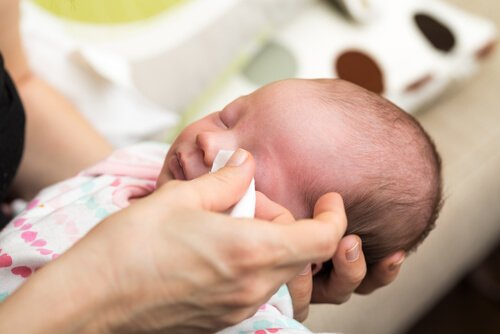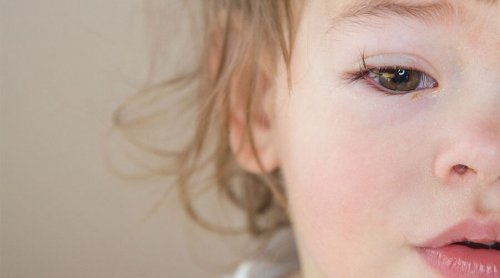What Are the Causes of Conjunctivitis in Babies?

It’s important for parents to be aware of the causes of conjunctivitis in babies, as this disease can affect their eyes starting at an early age.
Conjunctivitis is a common infection in newborn babies and young children that attacks the conjunctiva, a transparent membrane that lines the white part of the eye.
When the membrane becomes infected, the eye turns pink, giving way to the onset of conjunctivitis.
The causes of conjunctivitis in babies
There are several different causes of conjunctivitis in babies: a new infection caused by viruses and bacteria, an allergic reaction – produced by allergens – or an adverse chemical reaction to something placed directly on the eyes, causing irritation.
Below, we’ll describe each of the causes of this disease in detail:
Viral infection: Viruses are infectious microorganisms that attack the conjunctive membrane. Most of these viral infections are caused by adenoviruses – measles, rubella, the common cold, among others.
Bacterial infection: This occurs when bacteria contaminate the conjunctive membrane. It can happen in the mother’s vaginal tract, during natural birth – in newborns – and by touching surfaces contaminated by staphylococcus or streptococcus such as objects, towels, skin-to-skin contact.
Allergens: These are substances that can generate vulnerability or an allergic reaction to irritants such as dust, pollen, smoke, among others.
Chemicals: Irritation can occur as a reaction to the drops that are given to newborns after delivery to prevent infections caused by bacteria. It appears as mild eye irritation and lasts from 24 to 36 hours.
The symptoms of conjunctivitis in babies

It’s important to learn to identify which signs tell us that babies have conjunctivitis. Mothers should be very attentive to their children’s behavior.
Symptoms may vary depending on the causes of conjunctivitis. Below, we list the most common:
- Constant tearing.
- Sensitivity to light.
- More rheum than usual.
- Inflammation of the white part of the eye and the eyelid.
- Itchy and burning eyes.
- Red eye.
- White, yellow or greenish eye secretions.
Without a doubt, the first thing we should do when noticing any of the symptoms described above is to go to the pediatrician to get a diagnosis and follow the treatment indicated.
Treating conjunctivitis in babies
The treatment will depend on the type of conjunctivitis and its cause. For example, in most cases, viral conjunctivitis develops and heals without the need for any specific treatment.
In contrast, to relieve bacterial conjunctivitis, you must apply drops or antibiotic gel. In general, you can perform the following steps:
- Maintain the eyes properly cleaned by cleaning the area with cotton dipped in warm boiled water at least three times a day.
- The person performing the cleaning must always wash their hands thoroughly before doing so.
- Carefully place cold compresses on the eyelids.
- Apply artificial tears to soothe inflammation and dry eyes.
- Always use disposable material when removing secretions.
- Don’t share sheets, towels or clothes for the duration of the illness. Once the treatment is complete, wash them well.
“Allergic conjunctivitis can be treated with anti-allergens, although the irritative element that causes it must also be avoided”
Preventing conjunctivitis in babies

You can prevent babies from getting conjunctivitis. But to do so, it’s essential that parents take into account the following recommendations:
- Wash your hands frequently or carry antibacterial gel among your belongings so you can use it before handling the baby.
- Avoid sharing personal items such as towels, handkerchiefs, among others.
- If the baby suffers from allergies, consult with the pediatrician to avoid whatever causes it.
Finally, remember that, even when you take all of the precautionary measures, babies will always be exposed to external factors in the environment. Therefore, it’s very likely that at some point they’ll be affected by this highly contagious disease.
It’s important that parents inform themselves about the causes of conjunctivitis in babies so that they can treat it in time and achieve a faster recovery.
It’s important for parents to be aware of the causes of conjunctivitis in babies, as this disease can affect their eyes starting at an early age.
Conjunctivitis is a common infection in newborn babies and young children that attacks the conjunctiva, a transparent membrane that lines the white part of the eye.
When the membrane becomes infected, the eye turns pink, giving way to the onset of conjunctivitis.
The causes of conjunctivitis in babies
There are several different causes of conjunctivitis in babies: a new infection caused by viruses and bacteria, an allergic reaction – produced by allergens – or an adverse chemical reaction to something placed directly on the eyes, causing irritation.
Below, we’ll describe each of the causes of this disease in detail:
Viral infection: Viruses are infectious microorganisms that attack the conjunctive membrane. Most of these viral infections are caused by adenoviruses – measles, rubella, the common cold, among others.
Bacterial infection: This occurs when bacteria contaminate the conjunctive membrane. It can happen in the mother’s vaginal tract, during natural birth – in newborns – and by touching surfaces contaminated by staphylococcus or streptococcus such as objects, towels, skin-to-skin contact.
Allergens: These are substances that can generate vulnerability or an allergic reaction to irritants such as dust, pollen, smoke, among others.
Chemicals: Irritation can occur as a reaction to the drops that are given to newborns after delivery to prevent infections caused by bacteria. It appears as mild eye irritation and lasts from 24 to 36 hours.
The symptoms of conjunctivitis in babies

It’s important to learn to identify which signs tell us that babies have conjunctivitis. Mothers should be very attentive to their children’s behavior.
Symptoms may vary depending on the causes of conjunctivitis. Below, we list the most common:
- Constant tearing.
- Sensitivity to light.
- More rheum than usual.
- Inflammation of the white part of the eye and the eyelid.
- Itchy and burning eyes.
- Red eye.
- White, yellow or greenish eye secretions.
Without a doubt, the first thing we should do when noticing any of the symptoms described above is to go to the pediatrician to get a diagnosis and follow the treatment indicated.
Treating conjunctivitis in babies
The treatment will depend on the type of conjunctivitis and its cause. For example, in most cases, viral conjunctivitis develops and heals without the need for any specific treatment.
In contrast, to relieve bacterial conjunctivitis, you must apply drops or antibiotic gel. In general, you can perform the following steps:
- Maintain the eyes properly cleaned by cleaning the area with cotton dipped in warm boiled water at least three times a day.
- The person performing the cleaning must always wash their hands thoroughly before doing so.
- Carefully place cold compresses on the eyelids.
- Apply artificial tears to soothe inflammation and dry eyes.
- Always use disposable material when removing secretions.
- Don’t share sheets, towels or clothes for the duration of the illness. Once the treatment is complete, wash them well.
“Allergic conjunctivitis can be treated with anti-allergens, although the irritative element that causes it must also be avoided”
Preventing conjunctivitis in babies

You can prevent babies from getting conjunctivitis. But to do so, it’s essential that parents take into account the following recommendations:
- Wash your hands frequently or carry antibacterial gel among your belongings so you can use it before handling the baby.
- Avoid sharing personal items such as towels, handkerchiefs, among others.
- If the baby suffers from allergies, consult with the pediatrician to avoid whatever causes it.
Finally, remember that, even when you take all of the precautionary measures, babies will always be exposed to external factors in the environment. Therefore, it’s very likely that at some point they’ll be affected by this highly contagious disease.
It’s important that parents inform themselves about the causes of conjunctivitis in babies so that they can treat it in time and achieve a faster recovery.
All cited sources were thoroughly reviewed by our team to ensure their quality, reliability, currency, and validity. The bibliography of this article was considered reliable and of academic or scientific accuracy.
1. Tu, E. Y. Conjunctivitis. in Clinical Infectious Disease, Second Edition (2015). doi:10.1017/CBO9781139855952.015
1. Azari, A. A. & Barney, N. P. Conjunctivitis: A systematic review of diagnosis and treatment. JAMA – Journal of the American Medical Association (2013). doi:10.1001/jama.2013.280318
This text is provided for informational purposes only and does not replace consultation with a professional. If in doubt, consult your specialist.








